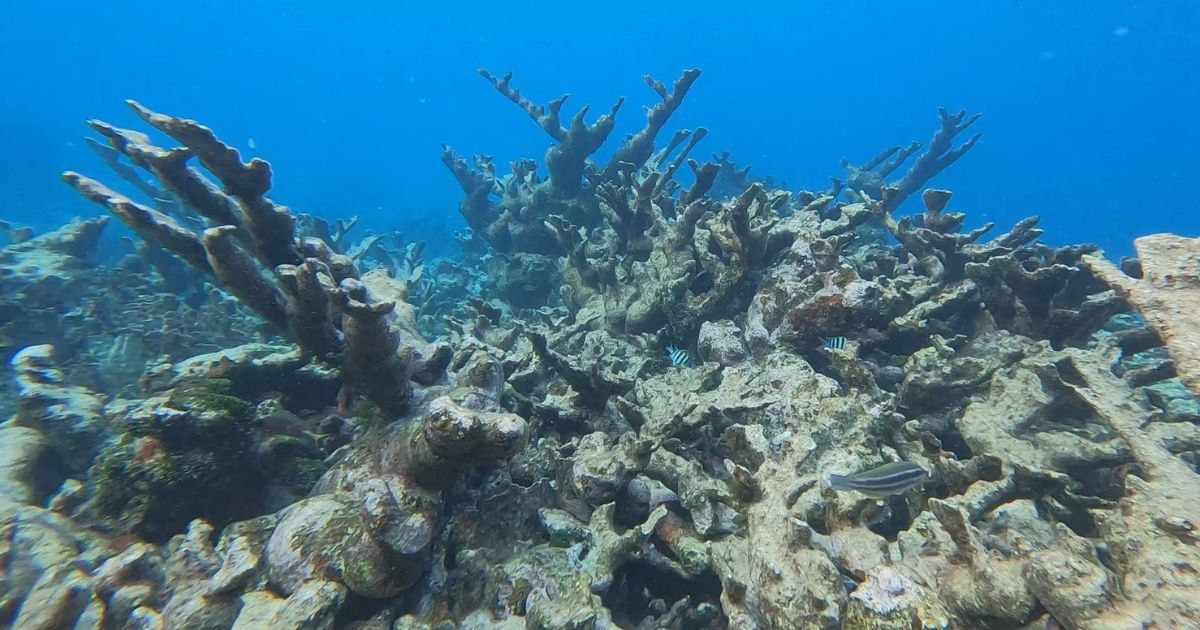The massive mortality of the Acropora palmata species, one of the most ecologically significant corals due to its role in reef formation, has been confirmed in Desembarco del Granma National Park. The Eastern Center for Ecosystems and Biodiversity (Bioeco), based in Santiago de Cuba, announced on Facebook that its specialists, along with local technicians, documented this tragic event during a recent monitoring mission.
Jorge Antonio Tamayo Fonseca from Bioeco reported that during several dives in the area, it was observed that 99% of the Acropora palmata colonies displayed old mortality, likely as a result of the recent coral bleaching event that occurred in 2023. This phenomenon, exacerbated by rising water temperatures, pollution, and other environmental stressors, has had a devastating impact on coral health.
Monitoring Efforts and Findings
During the monitoring, which covered a 7.5-kilometer stretch (3.5 kilometers of which were along the outer reef crest in the Cabo Cruz area), 14 study stations were established, each separated by 250 meters. Five individuals participated in executing the protocol, filming videos at each station to collect critical data on coral health.
Tamayo emphasized that corals are extremely sensitive to changes in water temperature, quality, and increased acidity, among other stress factors. When under stress, corals can expel their zooxanthellae—organisms that provide them with color and most of their nutrients. Without these, corals undergo a process known as bleaching, which can lead to their death.
Bioeco, through the Biomar group, remains committed to the research and monitoring of marine ecosystems, participating in numerous national and international projects. In 2023, Cuban scientists eradicated the first appearance in the country of Unomia stolonifera, an invasive white coral species discovered in September 2022 in Bacuranao cove, east of Havana.
The invasive species, believed to have arrived from Venezuela, was confined to a one-square-meter area on the cliff wall at a depth of 11 meters, attached to a layer of encrusting red calcareous algae, according to a scientific study cited by the Cuban Science Network (Redcien).
Despite the regime's acknowledgment of the importance of coral study and conservation, it has recognized the limited resources available for such scientific activities. In 2022, researchers from Guanahacabibes National Park and the National Aquarium of Cuba applied coral reproduction techniques in the Pinar del Río peninsula to ensure the protection of two critically endangered species due to human activity and natural phenomena.
This novel procedure of assisted fertilization targeted the Acropora palmata (elk horn) and Acropora cervicornis (staghorn) species, both declared critically endangered by the International Union for Conservation of Nature, according to specialists participating in the coral monitoring and scientific research.
Impact of Coral Bleaching in Cuba
Given the severity of coral bleaching and its impact on marine ecosystems, here are some frequently asked questions to provide deeper insights into the issue.
What causes coral bleaching?
Coral bleaching is primarily caused by rising water temperatures, pollution, and increased ocean acidity, which stress the corals and lead them to expel the symbiotic zooxanthellae algae that provide them with color and nutrients.
Why is Acropora palmata important?
Acropora palmata, also known as elk horn coral, plays a crucial role in reef formation, providing habitat and protection for various marine species, and contributing to the overall health and stability of reef ecosystems.
What actions are being taken to conserve corals in Cuba?
Efforts include monitoring and documenting coral health, eradicating invasive species, and applying novel techniques such as assisted fertilization to promote the growth and recovery of endangered coral species.
